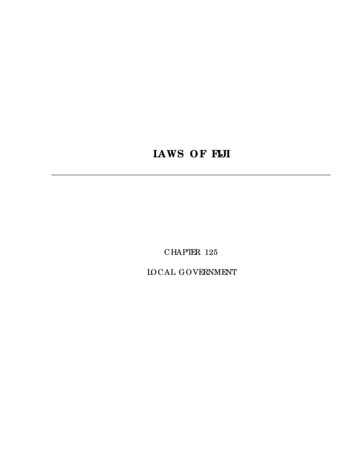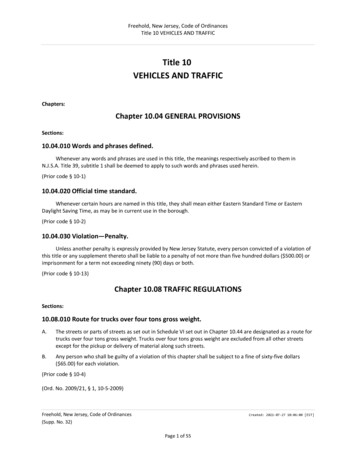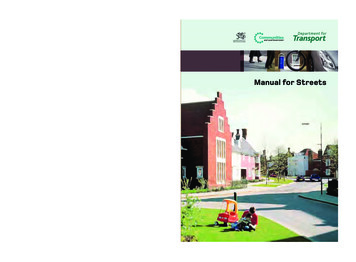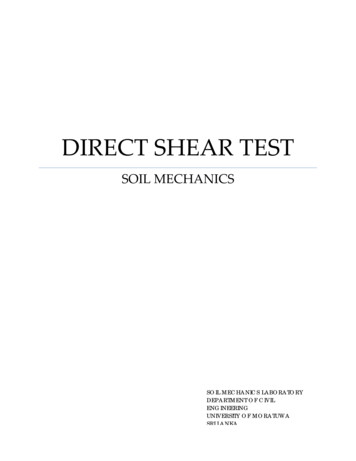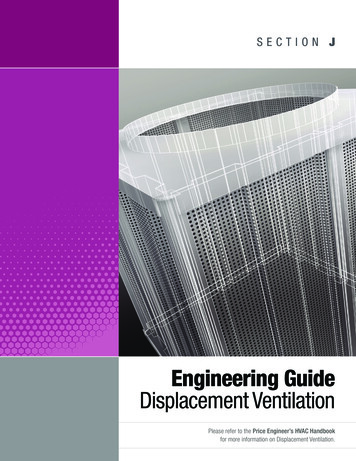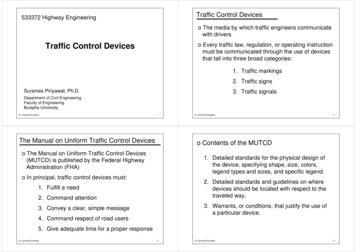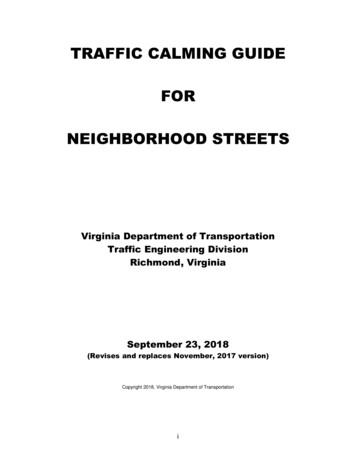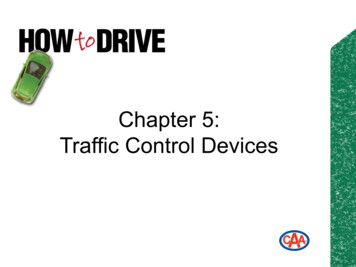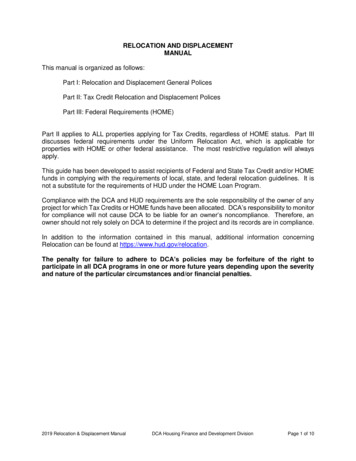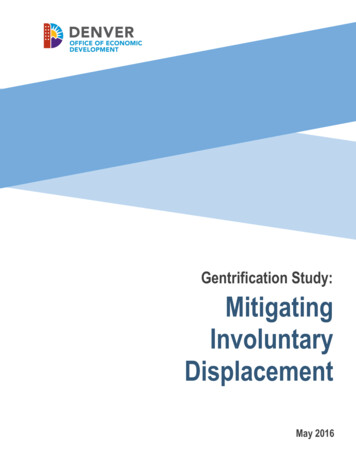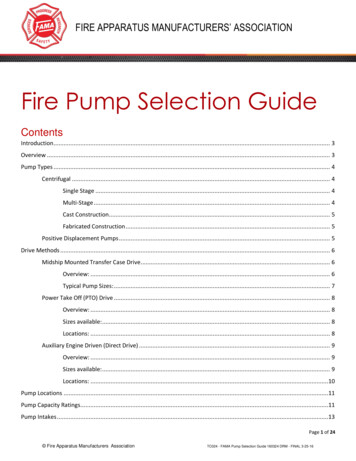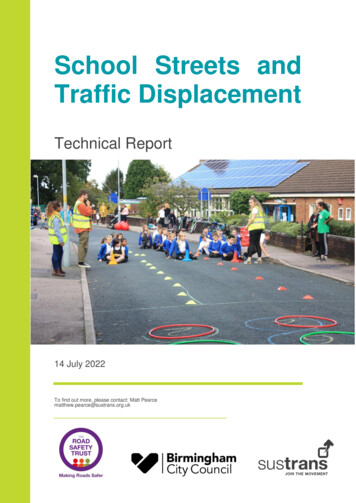
Transcription
School Streets andTraffic DisplacementTechnical Report14 July 2022To find out more, please contact: Matt Pearcematthew.pearce@sustrans.org.uk
Sustrans is the charity making it easier for people to walk and cycle.We connect people and places, create liveable neighbourhoods, transformthe school run and deliver a happier, healthier commute.Join us on our journey.www.sustrans.org.ukRegistered Charity No. 326550 (England and Wales) SC039263 (Scotland).Cover photo credit: Birmingham City CouncilDocument details1Reference ID:SUSR1996Version:6.0Client:The Road Safety TrustCirculation Status:External – client and key stakeholders (The Road Safety Trust and Birmingham CC)Issue Date:14/07/2022Author(s):Tom Belcourt-Weir, Chris Cannell, Matt PearceReviewed by:Matt PearceSigned off by:Anjali BadloeSUSR1996School Streets and Traffic Displacement14/07/2022
ContentsExecutive summary 41. Introduction 8Background 8Research aims 10Structure of the report 112. Literature Review 123. Methodology 13Developing on historic studies 13School locations 13Data collection 173.3.1Data collection phases 173.3.2Automatic traffic counters 183.3.3Video monitoring 213.3.4Postal surveys 234.Findings 24Traffic volumes during School Street hours 264.1.1Hillstone 264.1.2Somerville 29Comparing traffic volumes during and outside of the SchoolStreets hours 324.2.1Hillstone 324.2.2Somerville 33Wider traffic level changes 344.3.1Traffic volumes across Great Britain 34Traffic speed during School Streets hours 354.4.1Hillstone 354.4.2Somerville 40Video Analysis 424.5.1Hillstone 424.5.2Somerville 47Resident’s perceptions 524.6.12Hillstone 53SUSR1996School Streets and Traffic Displacement14/07/2022
4.6.2Somerville 56Discussion 614.7.1Overall road safety implications 614.7.2Individual schools 624.7.3Comparing short-term and long-term impact 634.7.4Parking 644.7.5Stewarding and road layout 644.7.6Covid-19 pandemic 654.7.7Weather 654.7.8Future research 665.6.ConclusionAppendicesKey termsLiterature review examplesMethodology6.3.1School contexts 736.3.2Examples of School Streets implementation 736.3.3Automatic traffic counter data 756.3.4Video monitoring 786.3.5Postal survey 86Monitoring considerationsTraffic volume summariesTraffic speed summariesLimitations36869697173SUSR1996School Streets and Traffic Displacement14/07/202287909298
Executive summaryThis report sets out the findings of a Sustrans project to measure the displacement impact ofrestrictions to through-traffic on roads outside schools. These timed restrictions, known as“School Streets”, are designed to improve safety, congestion and reduce pollution by reducinglevels of traffic on roads directly outside schools. However some of the benefits experienceddirectly outside schools may be compensated by disbenefits of greater traffic congestion onroads outside the School Streets barrier or on adjacent streets, with the potential to impactroad safety at these locations. Research on whether this is the case is sparse. We set out tocollect fresh evidence using a new combination of research methods. We report our findingsagainst the following key research question:“Do School Streets cause traffic displacement that may affect road safety onsurrounding roads?”MethodologyWe identified the key findings of the existing body of evidence on the impact of Schools Streetsby conducting a literature review. We followed this up with a field exercise to collect freshevidence on two Schools Streets primary schools in Birmingham. We chose the schools inquestion to see if road layouts would make a difference, one school being on a cul-de-sac andthe other being on a road with junctions at both ends. Figure 1 show maps of the School Streetsand surrounding streets.We captured evidence on the impact of the School Streets restrictions on traffic levels andbehaviour using traffic counters, video cameras and from local residents through postal surveysduring three phases: at baseline before the School Streets started (September 2020), shortlyafter the School Streets had started (October 2020), and seven months after the School Streetshad started (April/May 2021). More details on the methodology can be found in Section 3 andAppendix 6.3.4SUSR1996School Streets and Traffic Displacement14/07/2022
Figure 1: Maps of streets monitored at Somerville Primary School (left) and HillstonePrimary School (right): the School Street, surrounding streets with potential fordisplacement, and a control streetFindingsWe found 16 relevant existing studies on the impact of school street restrictions as a result ofour literature review. These showed in general that traffic levels usually fall during a SchoolStreet, and where there is traffic displacement, it either does not cause road safety issues orcan be mitigated.Our own fieldwork at two Birmingham primary schools with different surrounding street layoutsfound: overall traffic volumes, across the school road and surrounding roads, fell during theSchool Street time windows (school pick-up and drop-off times) which is likely to havehad an overall positive impact on road safety5SUSR1996School Streets and Traffic Displacement14/07/2022
in contrast, outside of the School Street time windows, overall traffic levels across thesame roads rose compared to before the School Streets. This suggests that a degreeof traffic evaporation (the disappearance of traffic when road space is reallocated awayfrom motorised vehicles) may have occurred as a result of the School Streets at one of the School Street sites - Hillstone Road - the average car speed rose slightlyafter the School Street was brought in, posing a potential safety risk, although thespeeds both before and after were relatively low1 our video monitoring showed that the School Streets had an impact on parkingbehaviour with an increase in the number of parked cars near the entrance to theSchool Street, and a higher number of parking cars interacting with other road users.The severity (e.g. a road user having to stop more imminently to avoid collision) ofinteractions did not increase as a result of the School Streets, but the increasednumber of interactions indicates a potential risk of worse road safety in these locations our follow up residents’ survey findings demonstrated strong support for the SchoolStreets initiative as well as an overall rise in the proportion of people who believed theschool road and surrounding roads were safe, compared to before the school streetwas implemented we did find some inconsistencies between the schools in the rigour with which theSchool Streets were stewarded by schools staff. In addition, we deliberately chose thetwo schools involved because of the difference in their surrounding road layouts.Nevertheless our findings at the two schools were broadly similar. It was not clear fromthe evidence we were able to collect what gave rise to the small differences in impactwe did find between the schools we found some change in the direction and extent of impact of both School Streetsover time, suggesting that there is a ‘bedding in’ period for such schemes.We developed a methodology to collect our evidence that was more sophisticated than mostof the research we came across in the literature review. We used a greater range of monitoringmechanisms and collected evidence across a wider road network surrounding the schools.Our fieldwork provides fresh, more granular, evidence to support the findings of the literaturereview. That School Streets lead to overall falls in volume of traffic and although traffic may bedisplaced to some degree to surrounding streets, the literature review suggests that measurescan be applied to successfully mitigate any associated road safety issues. Further research16we had insufficient vehicle speed data to make conclusions for the other School Street on Somerville RoadSUSR1996School Streets and Traffic Displacement14/07/2022
could investigate which School Street contexts have required mitigation measures, what kindof measures have been applied, and to what effect.7SUSR1996School Streets and Traffic Displacement14/07/2022
1. IntroductionThe aim of this project was to monitor trafficdisplacement around School Streets and evaluateany associated impact on road safety on surroundingstreets.BackgroundRoad safety continues to be a serious issue in the UK, particularly on the walk to school. In2019, there were 5,200 child pedestrian casualties on UK roads – 1,257 of which were seriousinjuries and 18 of which were deaths2. In 2015, 39% of incidents of children on foot being killedor seriously injured on UK roads occurred between 07:30am and 08:59am or between 15:00pmand 16:59pm on a school day3. One way of addressing school road safety is through theimplementation of School Streets.What are School Streets?School Streets aim to ease the road safety, congestion and air quality concerns that manyschools experience, by facilitating traffic restrictions on the road outside the school gatesduring drop-off and pick-up times. These are communicated beforehand and enforced bymechanisms such as signage, stewarding and traffic cones. The restriction applies to schooltraffic and through traffic, with exemptions for emergency vehicles, service providers, bluebadge holders and residents. Schools implement a School Street via the Local Authority,using a Traffic Management Order or Traffic Regulation Order.For definitions of key terms used throughout this report, see Appendix 6.1.School Streets are still relatively new interventions and as they become more frequentlyimplemented in the UK there is a need to understand whether they displace traffic and haveany knock-on effects on road safety in the surrounding area.2Department for Transport (2020) Reported Road Casualties Great Britain: 2019. vernment/uploads/system/uploads/attachment -report-2019.pdf.3Department for Transport (2016) Reported Road Casualties Great Britain: 2015. vernment/uploads/system/uploads/attachment data/file/568484/rrcgb2015.pdf The statistic required for the calculation of this percentage value is not available for any years after 2015.8SUSR1996School Streets and Traffic Displacement14/07/2022
The Road Safety TrustThe Road Safety Trust (RST) awarded a grant under their ‘Innovative traffic calming andprovision for vulnerable road users’ round of funding, to fill this research gap. The Road SafetyTrust is the largest independent road safety grant-giver in the UK and funds vital research andpractical interventions committed to reducing the number of people killed or injured on UKroads.Birmingham’s Car Free School StreetsTo capture evidence, we monitored traffic during Birmingham City Council’s ongoing schemeof School Streets, known as ‘Car Free School Streets’4. After a successful pilot year in 2019involving six schools, twelve schools in Birmingham have been implementing School Streetsfor the 2020 - 2021 academic year under Traffic Regulation Orders. Sustrans did not supportthe delivery of the School Streets; Birmingham City Council implemented them independentlyof Sustrans’ research project. Both schools had School Streets in place at the start and end ofthe school day. Motorised vehicles driving on the school road without a permit during therestrictions could be issued with a Fixed Penalty Notice charge of 50 5.What is road safety?In a strict sense, road safety can be seen as freedom from the liability of exposure toharm or injury on the highway. However, it is also important to consider road safety asmore than just the avoidance of harm. It must also consider the perception of risk of harm,at an individual and community level.Operationalising road safetyFor the purpose of this research we defined road safety using five key measures, supportedby the findings from a literature review that was conducted as part of the project (see LiteratureReview). They were: higher volumes of vehicular traffic: on individual surrounding streets and across thearea as a whole, increasing the risk of collisions higher vehicular traffic speeds: on individual surrounding streets and across the areaas a whole, increasing the risk of collisions. The association between speed and safetyis well established, with studies such as Rosén & Sander (2009)6 suggesting thatpedestrian fatality risk at 50 km/h vehicle impact is more than twice as high than at 40km/h, and five times higher than at 30km/h dangerous or illegal parking and driving behaviour: drivers parking on yellow lines,zig-zags or the pavement, pulling over in the road, and parking or manoeuvring in the4For more information on this scheme, seehttps://www.birmingham.gov.uk/info/20163/safer greener healthier travel/1891/car free school streets5Exemptions include residents, blue badge holders and emergency services.6Erik Rosén & Ulrich Sander (2009): Pedestrian fatality risk as a function of car impact speed, Accident Analysis &Prevention, Volume 41, Issue 3, Pages 536-542, https://doi.org/10.1016/j.aap.2009.02.002. [Accessed 26/11/2021]9SUSR1996School Streets and Traffic Displacement14/07/2022
School Street junction, increasing the risk of collisions. The literature indicates thatcases of drivers parking badly on neighbouring roads during School Streets is an issue,though there are not a high number of cases conflict between road users: where driver behaviour creates situations of potential,near or actual contact between road users, requiring participants to adjust or slow invarying degrees of severity, making the road more dangerous local residents’ perceptions of road safety: how safe parents and otherstakeholders believe the road to be. Results of this often differ to the objectivemeasures outlined above.Research aimsThe aim of this project was to address the following research question:“Do School Streets cause traffic displacement that may affect road safety onsurrounding streets?”The project’s evaluation objectives were to: understand the extent to which traffic displacement is caused by School Streets assess any associated displacement of road safety issues onto adjacent streets as aresult of the School Street (including high traffic volume, illegal parking, vehicle speedand unsafe road user interaction) measure perceptions of road safety on the School Street and adjacent streets, toassess any displacement of perceived safety issues.While local authorities have carried out preliminary evaluations of their schemes, there islimited understanding of the wider implications for road safety of School Streets – particularlyon the surrounding road network. Accordingly, this project will provide insight on commonconcerns about School Streets, including: traffic simply moving onto adjacent streets making those more dangerous parents driving to school and parking in the adjacent streets School Streets having no impact on existing levels of traffic, speeds or parking.Another secondary objective for the project was to assess the current evidence base on theimpacts of School Streets on traffic displacement and road safety. This was completed by DrAdrian Davis and can be found in the Literature Review section.10SUSR1996School Streets and Traffic Displacement14/07/2022
Structure of the reportThis report is set out in five sections: section two provides a summary of the literature review which assesses the existingevidence base surrounding displacement of traffic and safety issues onto roadssurrounding a School Street section three describes the methodology for the research section four presents the findings, split by road safety measure and monitoring location,and provides discussion of the findings 11section five concludes with the value and key findings of the project.SUSR1996School Streets and Traffic Displacement14/07/2022
2. Literature ReviewAs a key part of this study we commissioned a literature review of the existing evidence ondisplacement of traffic and associated road safety issues around School Streets. The reviewwas produced by Dr Adrian Davis, professor of transport and health at Edinburgh NapierUniversity, and published in August 2020 7. Findings from the review contributed to the designof this research project and helped to ensure that the starting point was as fully informed aspossible by previous instances of School Streets.Dr Davis reviewed 16 previous studies of School Streets, none of which were peer reviewedand one of which was a Master’s thesis. The locations covered by the studies includedCamden, Edinburgh, Solihull, Perth and Kinross, East Lothian, Croydon, Southampton, andthe region of Flanders, Belgium. Information from some of these studies can be found inAppendix 6.2. After it became clear that the literature on School Streets was limited, Dr Davisundertook five semi-structured interviews with local authority officers working on SchoolStreets. These supplemented the literature with up-to-date (as of March/April 2020)perspectives and evidence.Overall, the review found 8: strong and consistent evidence that traffic displacement does not cause road safetyissues of any significance and that mitigating measures, where needed, have beenapplied successfully medium strength evidence that in almost all cases the total number of motor vehicleson School Streets and neighbouring streets reduces medium strength evidence that perceived road safety on surrounding streets, as wellas the School Streets, improves as active travel rises medium strength evidence that alternative parking schemes such as “Park and Stride”help reduce traffic displacement, although a small number of badly parked vehiclescan remain an issue.The literature review findings contributed to the design of the methodology for monitoring andevaluating the traffic displacement and associated road safety impacts of the School Streetsby identifying monitoring tools to draw upon, and limitations in previous methodologies thatcould be avoided (e.g. monitoring of traffic levels on a very limited number of us/news/school-street-School StreetsThe findings are taken verbatim from the published literature review, available at:https://www.napier.ac.uk/ ew-final.pdf?la en812SUSR1996School Streets and Traffic Displacement14/07/2022
3. MethodologyTo assess the displacement effect of School Streets, we conducted a longitudinal study at twoBirmingham schools which were participating in Birmingham City Council’s ‘Car Free SchoolStreets’ scheme.Developing on historic studiesAs mentioned in the previous section, the literature review contributed to the design of themethodology in the research. The key ways in which it informed this methodology were: highlighting of the range of tools and measures that have been applied in themonitoring of School Streets interventions. This acted as a useful starting point whenconsidering an appropriate methodology. highlighting that many studies have tended to apply only one or two monitoring tools.By applying a range of monitoring tools in the methodology of this study it allows for aconsideration of a wider range of ‘traffic safety’ concepts, such as the measurement ofobjective indicators (e.g. traffic levels) and subjective indicators (e.g. perceptions oftraffic and safety). In addition, the variety of tools supports both generic measures (e.g.perceptions of school road vs surrounding roads) and school context specificmeasures (e.g. video observation of specific locations near the school) of traffic safety. highlighting that traffic monitoring is typically limited to the School Street and one ortwo other nearby roads, rather than the wider network of neighbouring roads ontowhich displacement may occur. By monitoring traffic over a wider area than monitoredin other studies, this study will provide a more robust account of whether trafficdisplacement occurs following the implementation of School StreetsSchool locationsSelecting schoolsWe carried out research at two of the twelve schools taking part in Birmingham City Council’sCar Free School Streets programme: Somerville Primary School in Small Heath, and HillstonePrimary School in Shard End (see Figure 2).13SUSR1996School Streets and Traffic Displacement14/07/2022
Somerville Primary School is located on a cul-de-sac in a mixed residential and business area,while Hillstone Primary School is situated in a residential area on a road with junctions at bothends. These different local contexts provide the opportunity to compare findings between theschools and indicate whether the road layout context is potentially a significant variable indetermining the displacement impact of a School Street. It should be noted that the two schoolsalso differ in several other respects shown in Table 1. Ward-level data is shown for Shard Endward (where Hillstone School is situated) and Small Heath ward (where Somerville School issituated) and shown in Table 1.Table 1: Data collection methods with relevant road safety characteristicsSchool contextHillstone SchoolSomerville SchoolHistoric share of pupils beingdriven to school47% of pupils driven to school in2013/24 academic year23% of pupils driven to school in2012/13 academic yearSchool catchment area size1.3 miles from school0.5 miles from schoolDemographic characteristic910Shard EndSmall HeathEmployment rate59.1%36.9%% Under 18 years of age25.6%36.9%Index of Deprivation 2015 nationalrank of ward (out of 7,511 wards,lower rank is more deprived)1391759Shard End ward factsheet (Census ads/id/15497/shard end profile.pdf10Small Heath ward factsheet (Census ads/id/15498/small heath profile.pdf14SUSR1996School Streets and Traffic Displacement14/07/2022
Figure 2: Map of monitored schools and other schools in BirminghamFigure 3 and Figure 4 show maps of each school location. When planning our monitoring, wetook into account the entrances being used for pupil access, including any special Covid-19measures.Figure 3: Map of Hillstone Primary School with School Street and entrances15SUSR1996School Streets and Traffic Displacement14/07/2022
Figure 4: Map of Somerville Primary School with School Street and entrancesImplementation and stewarding of School StreetsThe School Streets timed restrictions were implemented through signage, stewarding andcones at both schools.The extent to which a School Street is stewarded is likely to influence compliance with therestrictions and therefore the impact of the School Street. At Hillstone Primary School weobserved that the stewarding started and stopped at roughly the same time (i.e. within a coupleof minutes) as the times indicated on the signage.However, due to staff shortages and the Covid-19 pandemic, the stewarding at SomervillePrimary School varied slightly from the intended times (see Appendix 6.3.1 for the statedmonitoring times). During the week of monitoring shortly after the implementation of the SchoolStreets, the stewarding generally started at the same time as indicated on the signage, butalways stopped between 15 to 30 minutes early. On the Friday afternoon there was nostewarding. During the follow-up data collection phase, the hours of stewarding were shorter(between 15 to 20 minutes) and there was no stewarding observed during the afternoon hours.More detail about each school and their School Streets implementation can be found inAppendices 6.3.1 and 6.3.2.16SUSR1996School Streets and Traffic Displacement14/07/2022
Data collectionTable 2 lists the data collection methods used to monitor the relevant road safetycharacteristics. All three data collection tools were delivered by external contractors.Table 2: Data collection methods with relevant road safety characteristicsData collection methodSafety characteristics assessedAutomatic traffic counters (ATCs)Traffic volumesTraffic speedsVideo monitoringIllegal or unsafe parkingRoad user interactions including pedestrian crossingsPerceptions of road safety (traffic volume, traffic speed, traffic behaviour,crossing the road, safety for the person and for children)Postal surveys3.3.1 Data collection phasesData collection took place over three phases: baseline (before any School Streets wereimplemented), during intervention (within the first few weeks of the School Streets) and followup (six to seven months into the School Streets, while it is still running). Exact dates are shownin Table 3. By comparing the data at each phase, we identified any changes in trafficdisplacement or road safety around the School Street interventions.Table 3: Dates of baseline, during and follow-up monitoring, by method and locationBaseline (2020)During intervention (2020)Follow-up (2021)Data toneSomervilleHillstoneAutomatic TrafficCounters21st – 25thSep 202014th – 20thSep 202012th – 18thOct 202012th – 18thOct 202010th – 16thMay 202110th – 16thMay 2021Video monitoring21st – 25thSep 202016th – 23rdSep 202012th – 16thOct 202012th – 16thOct 202010th – 14thMay 202110th – 14thMay 2021Perceptionsurveys13th – 28thSep 202013th – 28thSep 2020N/AN/A4th – 21st Apr20214th – 21st Apr202117SUSR1996School Streets and Traffic Displacement14/07/2022
Figure 5: Timeline of data collection phases before and during School StreetsBaselinedata collectionDuringdata collectionFollow-updata collectionSeptember2020October2020May 2021School Streetsstart3.3.2 Automatic traffic countersAutomatic traffic counters (ATCs) were temporarily installed on roadsides to count vehicles andrecord their speeds for seven days of 24-hour data recording at each data collection phase. Ageneral explanation of the ATC locations, how the data was analysed and information onmissing data is given in Appendix 6.3.3. The specific ATC locations for each of the two schoolsare shown below.ObjectivesThe traffic speed and volume (TSV) data generated by the ATCs supports the followingobjectives: understand the extent to which traffic displacement is caused by School Streets assess any associated displacement of road safety issues onto adjacent streets asa result of the intervention (for this objective, the relevant road safety issue isvehicle speed) understand if there has been any evaporation of traffic from the school area, andimplications on road safety issues.18SUSR1996School Streets and Traffic Displacement14/07/2022
HillstoneAs shown in Figure 6, one TSV location was on the School Street itself, Hillstone Road (TSV1). Five were then located on potential displacement routes. Two of these were on FreasleyRoad (TSV 2) and Hillstone Road (TSV 5) near to the School Street entrance, to capture themost likely locations of new pick-up/drop-off points. Two more were located on Nearmoor Road(TSV 3 and TSV 6), as a parallel road which might be used by displaced traffic. One waslocated on Pithall Road (TSV 4) to capture traffic potentially circling back after drop-off/pick-up.Finally, Bradley Road (TSV 7) was used as a control location.Figure 6: Traffic Speed & Volume (TSV) locations for Hillstone Primary School19SUSR1996School Streets and Traffic Displacement14/07/2022
SomervilleAs shown in Figure 7, one TSV location was on the School Street itself, Somerville Road (TSV1). Five were then located on potential displacement routes. Two of these were on CharlesRoad (TSV 2) and Somerville Road, near to the school street entrance (TSV 6). Two morewere located on parallel roads Kenelm Road (TSV 3) and Swanage Road (TSV 4). One wasalso located on the B4145 (TSV 5) to capture traffic potentially using the B145 instead ofSomerville Road to drop-off/pick-up. Finally, the control location was on Carlton Road (TSV 7).Figure 7: Traffic Speed & Volume locations for Somerville Primary School
School Streets and Traffic Displacement 14/07/2022 SUSR1996 1. Introduction The aim of this project was to monitor traffic displacement around School Streets and evaluate any associated impact on road safety on surrounding streets. Background Road safety continues to be a serious issue in the UK, particularly on the walk to school. In
